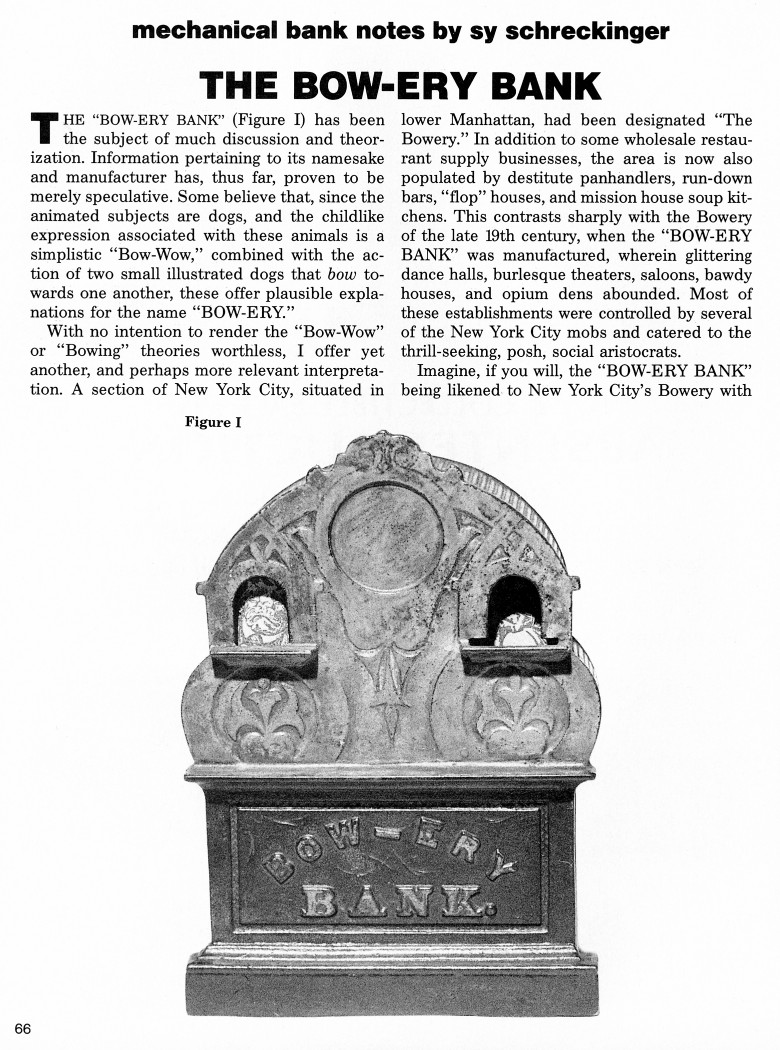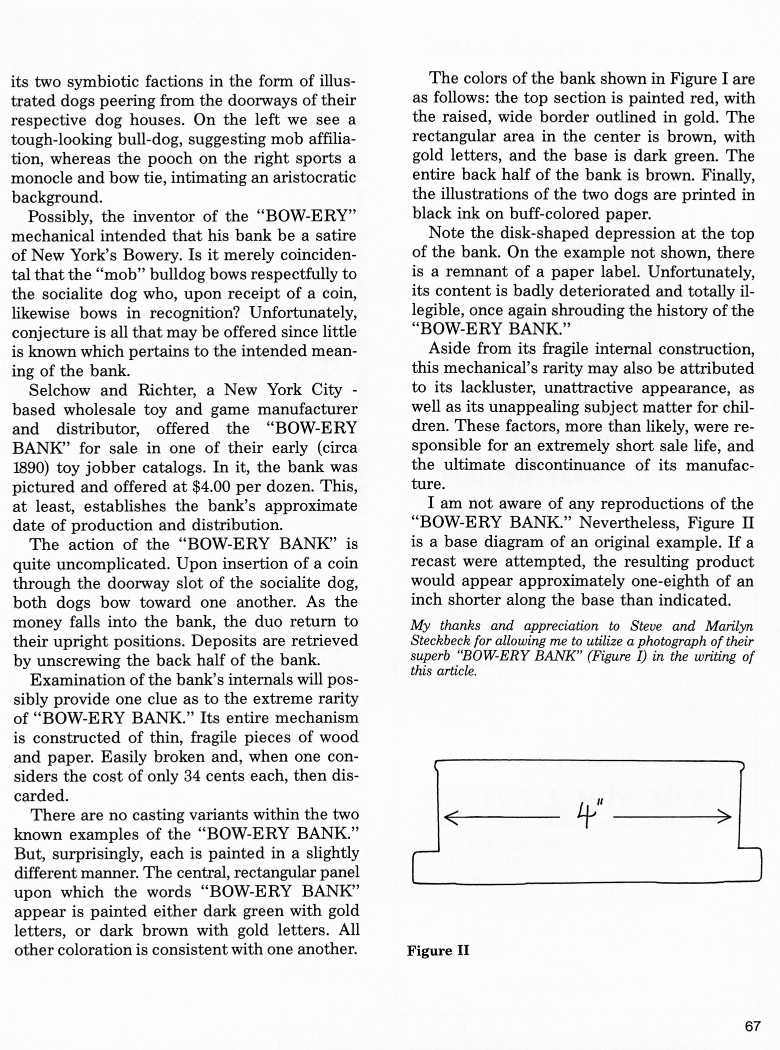|
The Bow-Ery Bank
by Sy Schreckinger – ANTIQUE TOY WORLD Magazine – March, 1994
The "Bow-Ery Bank" (Figure I) has been the
subject of much discussion and theorization. Information pertaining to
its namesake and manufacturer has, thus far, proven to be merely
speculative. Some believe that, since the animated subjects are dogs, and
the childlike expression associated with these animals is a simplistic
"Bow-Wow," combined with the action of two small illustrated dogs that bow
towards one another, these offer plausible explanations for the name
"BOW-ERY."
With no intention to render the "Bow-Wow" or "Bowing" theories
worthless, I offer yet another, and perhaps more relevant interpretation.
A section of New York City, situated in lower Manhattan, had been
designated "The Bowery." In addition to some wholesale restaurant supply
businesses, the area is now also populated by destitute panhandlers,
rundown bars, "flop" houses, and mission house soup kitchens. This
contrasts sharply with the Bowery of the late 19th century, when the "BOW-ERY
BANK" was manufactured, wherein glittering dance halls, burlesque
theaters, saloons, bawdy houses, and opium dens abounded. Most of these
establishments were controlled by several of the New York City mobs and
catered to the thrill-seeking, posh, social aristocrats.
Imagine, if you will, the "BOW-ERY BANK" being likened to New York
City's Bowery with its two symbiotic factions in the form of illustrated
dogs peering from the doorways of their respective dog houses. On the left
we see a tough-looking bulldog, suggesting mob affiliation, whereas the
pooch on the right sports a monocle and bow tie, intimating an
aristocratic background.
Possibly, the inventor of the "BOW-ERY" mechanical
intended that his bank be a satire of New York's Bowery. Is it merely
coincidental that the "mob" bulldog bows respectfully to the socialite
dog who, upon receipt of a coin, likewise bows in recognition?
Unfortunately, conjecture is all that may be offered since little is known
which pertains to the intended meaning of the bank.
Selchow and Richter, a New York City based wholesale toy and game
manufacturer and distributor, offered the "BOW-ERY BANK" for sale in one
of their early (circa 1890) toy jobber catalogs. In it, the bank was
pictured and offered at $4.00 per dozen. This, at least, establishes the
bank's approximate date of production and distribution.
The action of the "BOW-ERY BANK" is quite uncomplicated. Upon
insertion of a coin through the doorway slot of the socialite dog, both
dogs bow toward one another. As the money falls into the bank, the duo
return to their upright positions. Deposits are retrieved by unscrewing
the back half of the bank.
Examination of the bank's internals will possibly provide one clue as
to the extreme rarity of "BOW-ERY BANK." Its entire mechanism is
constructed of thin, fragile pieces of wood and paper. Easily broken and,
when one considers the cost of only 34 cents each, then discarded.
There are no casting variants within the two known examples of the
"BOW-ERY BANK." But, surprisingly, each is painted in a slightly different
manner. The central, rectangular panel upon which the words "BOW-ERY BANK"
appear is painted either dark green with gold letters, or dark brown with
gold letters. All other coloration is consistent with one another.
The colors of the bank shown in Figure I are as follows: the top
section is painted red, with the raised, wide border outlined in gold. The
rectangular area in the center is brown, with gold letters, and the base
is dark green. The entire back half of the bank is brown. Finally, the
illustrations of the two dogs are printed in black ink on buff-colored
paper.
Note the disk-shaped depression at the top of the bank. On the
example not shown, there is a remnant of a paper label. Unfortunately, its
content is badly deteriorated and totally illegible, once again shrouding
the history of the "BOW-ERY BANK."
Aside from its fragile internal construction, this mechanical's
rarity may also be attributed to its lackluster, unattractive appearance,
as well as its unappealing subject matter for children. These factors,
more than likely, were responsible for an extremely short sale life, and
the ultimate discontinuance of its manufacture.
I am not aware of any reproductions of the "BOW-ERY BANK."
Nevertheless, Figure II is a base diagram of an original example. If a
recast were attempted, the resulting product would appear approximately
one-eighth of an inch shorter along the base than indicated.
My thanks and appreciation to Steve and Marilyn Steckbeck for
allowing me to utilize a photograph of their superb "BOWERY BANK" (Figure
I) in the writing of this article.
|


